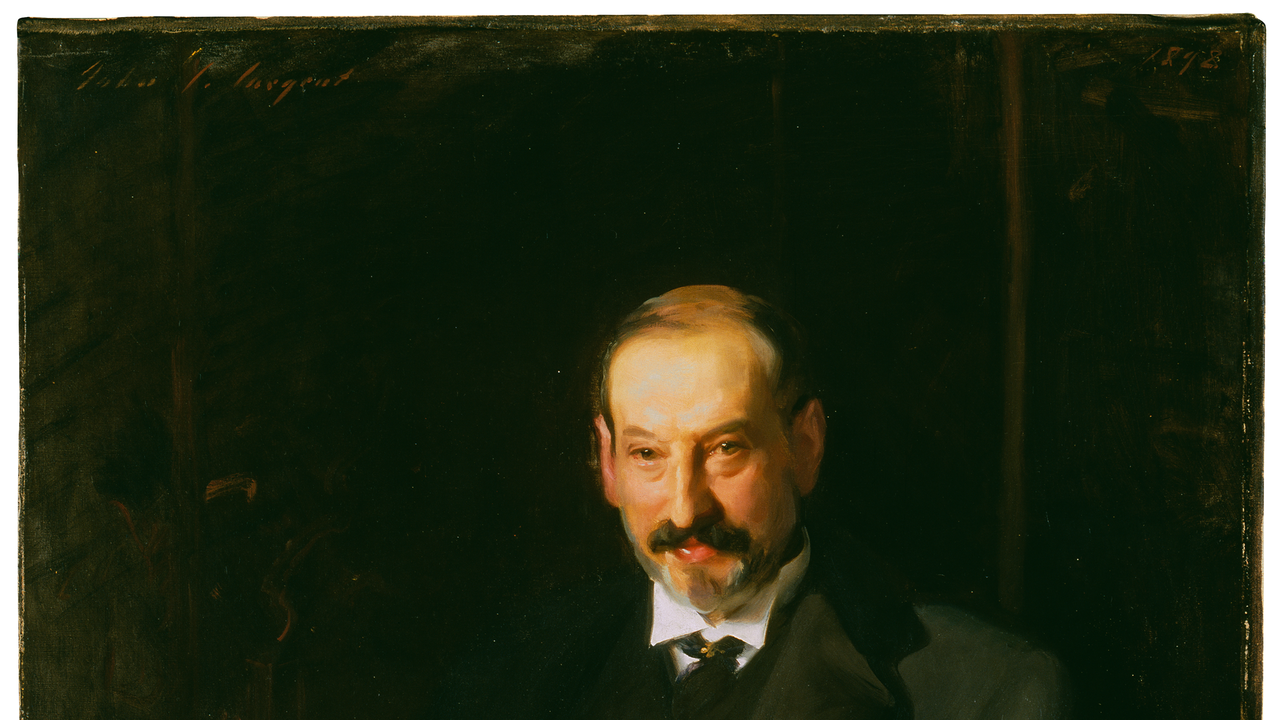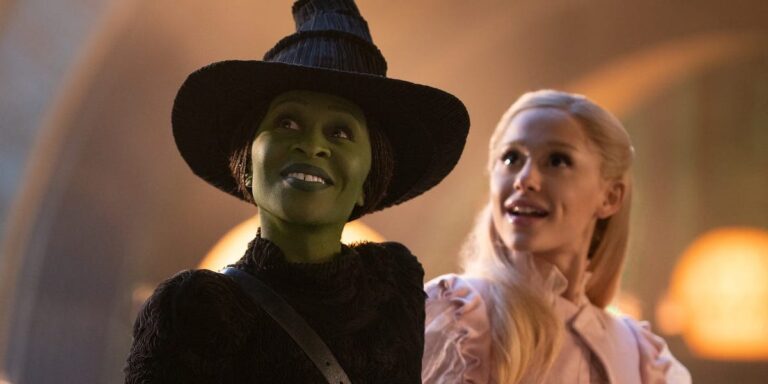If you remember anything about this painting, may it be that the dog’s name is Noble. The black poodle in the bottom left greets us as a silhouette with a few shiny parts: teeth, eye, damp nose, pink tongue. The teeth could crack bone; the tongue wants to be friends. Not a very dignified pose for a creature called Noble, but humans love to saddle animals with teasingly grand names—Rex, Princess, King, Queenie. It’s one of our many little ways of being modest and boastful in the same breath, of displaying our possessions and hinting that we are, in both senses, above it all.
The man girthily looming over Noble is not a noble. You might be able to tell by his coat, which blends into the blackness as easily as his pet’s fur. But his hands are the bigger giveaway—he’s no manual laborer, yet you sense that he uses them all the time. They speak every language, know classical rhetoric and differential calculus, have interesting opinions about the Berlin Conference. One sinks a thumb in his pocket. The other pokes at us with a cigar. Wordlessly, both announce, “We know exactly what we’re talking about.” They belong to a man named Asher Wertheimer, and in the years leading up to this portrait’s unveiling, in 1898, he became fantastically wealthy by dealing art. To celebrate his talent for persuading people to buy expensive objects, he has hired the famous John Singer Sargent and done what nobles do: converted himself into an expensive object.
What does Asher Wertheimer think about all this? He’s too smart to miss the ironies of an art dealer made art, but whether they taste sweet or bitter he won’t say. His red lips are freshly licked, and his eyes shoot out at us as vigorously as his cigar. People have stared at his stare and found warmth, or greed, or amusement, or wickedness, but there is a deliberateness to that expression, whatever it is. Some interpreted the painting as a Jewish caricature, and condemned or praised it accordingly, which did nothing to stop Asher from paying Sargent to give his family the same treatment. “What a tiresome thing,” the artist wrote, “a perfectly clear symbol would be.”
“Family Romance: John Singer Sargent and the Wertheimers” (Farrar, Straus & Giroux), Jean Strouse’s new book about Asher, Asher’s portrait, and the eleven that followed, is neither the trough nor the crest of our current wave of Sargentolatry, which so far has seen major shows at the Boston Museum of Fine Arts, the National Gallery, the National Portrait Gallery, the Jewish Museum, the Gardner, and Tate Britain. Next year, the centennial of the artist’s death, the Met opens its second Sargent blockbuster in a decade; to these we can add things like “The Man in the Red Coat,” the 2019 study of the surgeon Samuel-Jean Pozzi that Julian Barnes was moved to write after laying eyes on Sargent’s portrait, and HBO’s “The Gilded Age,” starring precisely the kinds of socialites Sargent painted and, come Season 3, Sargent himself.
He has never really gone away. That’s the mixed blessing of painting everyone from Gilded Age to Progressive Era: Henry James, Robert Louis Stevenson, Theodore Roosevelt, Woodrow Wilson, Fort Knoxes’ worth of Morgans and Rockefellers and Vanderbilts. If you were fumbling for conversation with an heiress, it used to be said, you could always ask her, “And how do you like your Sargent drawing?” As modernism bloomed and the Gilded Age became a punch line, so, inevitably, did its premier portraitist. D. H. Lawrence thought that his stuff was “nothing but yards of satin.” Picasso made him look antique. Even at the end of the twentieth century, when modernist aesthetics had long since gone the way of whalebone corsets, Sargent’s cheerleaders mostly seemed to accept the premise that he was a docile ennobler of rich oafs, if a very talented one. “He had no interest in politics past or present,” Robert Hughes wrote, in 1999, “was completely without class resentment and seemed to be devoid of irony.”
“No interest” . . . “completely without” . . . “devoid of”—it’s easy to talk about the past in all-or-nothing formulations. When we laud an artist for being “a shrewd observer of his times,” say, we usually mean that he stood apart from them and, if they’re as easily mocked as the Gilded Age, sneered. This is a roundabout way of putting the present’s ultimate compliment: that the artist is one of us. Even if that were possible, I don’t know why we’d prefer it. Aren’t the most interesting people the ones who can’t make up their minds about their world, who sometimes sneer and sometimes grovel? Each of Strouse’s previous books is about a person like this: J. P. Morgan, the pitiless financier, who said, “I owe the public nothing,” but donated entire museums of masterpieces anyway; Alice James, who saw the hollowness of marriage in her social circle yet believed that matrimony was “the only successful occupation that a woman can undertake.” Seeing through their age’s markers of value was no barrier to being seduced.
“Looking back on one hundred years of its own history in 1876, the United States did not yet have much aesthetic tradition or taste; it did have ardent cultural nationalism, and its cities were becoming vital centers for the arts.” This sentence, from “Morgan: American Financier,” would be equally at home in Strouse’s other books. Where some have found stuffiness in the decades leading up to the First World War, she sees flux, ambition, a sociopathic need for recognition—more precisely, she sees stuffiness as the truest sign of these things, revealing them by stubborn denial. Nothing was steady in those years. Not the American economy, which twitched from panic to triumph to panic and, in 1907, had to be bailed out with private funds from Morgan and his associates. Not the European aristocracy, which surrendered much of its wealth to industrialization and estate taxes. At times, beautiful objects must have seemed the only constants: porcelain, pearl necklaces, Louis XIV furniture, Old Master oils. A well-trained artist could make himself useful on both sides of the Atlantic, confirming with his brush that a new-money banker suddenly had real status and that a penniless duchess still hung on to some.
Not that beautiful objects were steady, either. Strouse tells of how the Cartier mansion, in midtown Manhattan, was purchased, in 1917, with a pearl necklace valued at $1.2 million. A few years later, when cultured pearls were becoming popular, the necklace had to be sold for a pathetic fraction of that sum. (Today, the Cartier mansion is worth well over a hundred million dollars.) The only stable currency was human insecurity, and those who trafficked in it did very well for themselves. It seems almost superfluous to add that the late nineteenth century saw the birth of our current, jumpy art market.
“Family Romance” swats away easy summary. Its barely two hundred and fifty pages are not a biography of Sargent, or a definitive history of the Gilded Age or its trappings, or a definitive account of anything. The inciting incident is Asher’s decision to leave Sargent’s portraits of his family to the British state (ten reside at Tate Britain), and most of the rest orbits the little we know of his life the way big, bright stars orbit a black hole.
He was born in London in 1843 and completed his formal schooling in Paris. His father, Samson Wertheimer, was born in Bavaria, at the time one of the few parts of Europe where Jewish business flourished, but he moved to England when he was a young man. While his children were still coming of age, Samson made his reputation selling chairs and cabinets to the Rothschilds. In 1874, the year he turned sixty, the Duke of Edinburgh commissioned him to decorate his mansion; had the gig come earlier, he might have sent Asher to Oxford instead.
The second-generation tycoon, classically, mimics the founder’s work ethic but adds polish. (Generation three is when things start getting sad.) At the age of twenty-seven, Asher made what they used to call “a brilliant marriage” to Flora Joseph, the daughter of another Jewish art-dealer dynasty, and when his father died, in the eighteen-nineties, he inherited the contemporary equivalent of tens of millions of dollars. By this point, he was selling Old Masters to William K. Vanderbilt, in New York, and to the major national collections in Berlin. The market for beautiful objects had changed so much in a generation that it barely counted as the same job. Authenticity was hot, hot, hot: the Rothschilds who hired Samson had been satisfied with shiny new furniture in the style of the eighteenth century, but the robber barons adding to Asher’s fortune wanted to pad their pedigrees with originals. For that they needed authenticators, and for those they had to rely on dealers who could convey a suave, chummy trustworthiness. Polish was half the job, minimum.
Not everyone liked that about it. Art dealing, Edmond de Goncourt wrote, in 1877, “is no longer, in the person of the seller, in a position of inferiority vis-à-vis the buyer, who on the contrary seems beholden to the seller.” Another way of putting this is that the material rewards for bending the truth about old art could have made the Dalai Lama a con man. In the most acidly delightful chapters of “Family Romance,” we’re told how a whole generation of elegant weasels, from the art historian Bernard Berenson to the dealer Lockett Agnew, of Thomas Agnew & Sons, paid for their summer houses by suckering clueless patrons. Agnew’s favorite trick was to acquire a painting attributed to the “school of” an Old Master, give it a clean, persuade some hired gun with a doctorate to recategorize it as an Old Master, and sell. Berenson charmed Isabella Stewart Gardner into spending thirty thousand pounds (something like six million dollars today) on a trio of Dutch oils she could have got for twenty-five. After the sale went through, Berenson pocketed the difference, plus a two-thousand-dollar bonus for his integrity. Later on, he accepted a contract with a firm that gave him “a financial incentive to ‘upgrade’ attributions.” Whether he actually did, Strouse does not say and doesn’t need to. If you’re still inclined to trust him, or at least to pray that this kind of mischief no longer goes unpunished, I can think of a certain painting—bought for four figures, cleaned, promptly bumped from “school of Leonardo” to genuine article, and sold, in 2017, for half a billion dollars—that might be of interest.
Where was Asher in all this? It’s not always easy to know, Strouse acknowledges, since his firm’s records have been lost. By and large, though, her suspicion is that he was “playing by gentlemanly rules in a newly cutthroat market.” It’s the same problem that every minority pioneer faces—how to conduct yourself in a society that already expects you to misbehave—with the further, infuriating twist that lying very nearly was the rule in Wertheimer’s industry. Devious, new money, rootless, greedy: what bothers us most about other people is, usually, what we hate most in ourselves. Reading Strouse, you get the impression that the antisemitic slurs that Wertheimer tried to avoid were secret self-portraits of a society that had resorted to inventing roots for itself, one bogus Old Master at a time. By the early twentieth century, Asher seems to have decided that the simplest way to insure continuity of business, besides acting honorably, was to remove his name from deals his firm secured. It worked, too well. Within a few decades, “Wertheimer” had disappeared from art dealing, and the firm along with it. Agnew’s is still going strong in 2024.
“Cosmopolitan,” another key antisemitic word of the era, was often applied to Sargent. He was born in Florence in 1856, grew up all over the continent, spoke English, French, Italian, and German, and seemed to be at ease anywhere, as long as there was a butler. Strouse doesn’t do too much huffing and puffing to acquit him of prejudice, which is merely to say that he was innocent in some ways and guilty in others. He painted a large number of Jewish sitters and took his lumps from Jew-haters for doing so. He took them from Jews, too, after he painted a mural of a feeble hag who represented their religion. In his thrilled insistence that the skin of his patron Sybil Sassoon was “positively green,” it is hard to hear much but garden-variety exoticizing.
We are about halfway through a big Sargent rethink, I hope. The yards of satin are still being excavated: the rediscovery of steamy nude portraits of the young Black model Thomas Eugene McKeller inspired “Boston’s Apollo,” at the Gardner, the most revelatory recent Sargent show and one of several determined to slay his reputation for squareness. The best comparison here is his friend Henry James, whose image as cold-blooded Master began to thaw with the rise of queer theory, in the eighties. We now open “The Portrait of a Lady” and chuckle at big, stiff Caspar Goodwood and Ralph Touchett, who ogles his cousin from behind and shows her his candlestick, and wonder how anybody ever missed the obvious. We still look at Sargent and miss away. He can be so naughty, flinging filthy jokes at an audience unsure if it’s allowed to laugh. His portrait of Pozzi, the playboy gynecologist who insisted on manually examining his patients, shows the “Love Doctor” (his actual nickname!) fingering the string of a scarlet dressing gown. “The flashiness,” Elaine Kilmurray wrote, in 2015, “is offset by the refinement of his finely drawn surgeon’s hands.” Until distinguished art historians catch up with puerile eighth-grade boys, I’m afraid, Sargent will stay square.




















+ There are no comments
Add yours